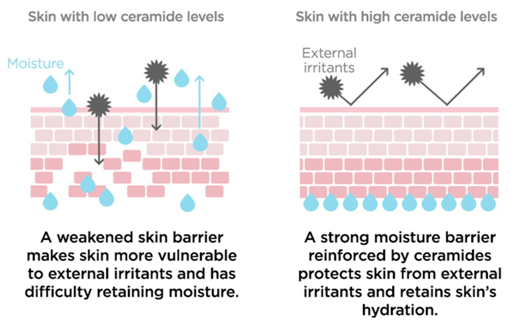1. What is Ceramide?
Ceramide is a kind of sphingolipid composed of sphingosine and fatty acids. It can be found in stratum corneum of human skin, up to 50%. This is why ceramide has a repairing effect on skin. Ceramide uses in skin care mainly show in ceramide cream, ceramide lotion, ceramide moisturizer, ceramide serum, etc.
2. Ceramides Source
2.1 Natural extraction
① Ceramides of animal origin is extracted from the brain and spinal cord of horses.
② Ceramide extracted from plant sources: corn, soybean and konjac and other plants.
2.2 Synthetic source
① Ceramide from microbial fermentation
The yeast is used to ferment under a certain environment to obtain tetraacetyl phytosphingosine, and then deacetylate it to obtain phytosphingosine, and add fatty acids to synthesize ceramides.
② Ceramides-like
Chemically synthesized substances, is also a lipid, pseudoceramide. Its properties are similar as natural ceramide, but the structure is different. It can be understood as ceramide analogues.
3. Ceramides Types and Efficacy
| Ceramides classification and efficacy | ||
| Classification | Efficacy | |
| Arabic numeral name | INCI name | |
| Ceramide 1 | CERAMIDE EOS | Moisturizing, protects skin from external irritation. |
| Ceramide 2 | CERAMIDE NS | Moisturizing, regulate water and oil balance |
| Ceramide 3 | CERAMIDE NP | Moisturizing, reduces wrinkles |
| Ceramide 4 | CERAMIDE EOH | Maintain skin barrier function, water retention |
| Ceramide 5 | CERAMIDE AS | Moisturizing, reduces wrinkles |
| Ceramide 6 | CERAMIDE AP | Moisturizing, helps with stratum corneum metabolism |
| Ceramide 6 Ⅱ | CAPROYL SPHINGOSINE | Helps with cell renewal and reduces wrinkles |
| Ceramide 7 | CERAMIDE AH | Regulates cell proliferation, differentiation, balances the flora |
| Ceramide 8 | CERAMIDE NH | Moisturizing |
| Ceramide 9 | CERAMIDE EOP | Moisturizing, repairs skin barrier |
Plamed mainly develops Ceramide NP, it’s white powder with 90% purity.
4. Ceremide Uses in Skin Care
The stratum corneum of skin is like city wall. And ceramid is mortar between bricks on the wall. If skin lacks ceramide, just like building a house without mortar on the bricks, the wall will inevitably fall. So ceramide plays a vital role for skin. It forms a protective film that makes skin firmer. Ceramide prevents skin moisture loss, and protects skin from pollution and other environmental stresses. It acts as a barrier to repair skin.

Ceramides uses in skin care have the following main effects:
4.1 Ceremide Uses in Repair Skin Barrier Effect
The skin barrier function as skin to block foreign matter immersed into skin tissue; and it is related to skin lipid. As the main component of skin lipids, ceramides form the wall of skin and act as a barrier to protect skin.

4.2 Ceremide Uses in Moisturizing Effect
Ceramide has a strong ability to associate water molecules. It maintains skin moisture through network structure formed in stratum corneum. Thus it prevents water loss. Applying 0.2% ceramide solution to dry skin, skin moisture recovery is remarkable. The structure and roughness of skin are also improved.

4.3 Ceremide Uses in Water Retention
The structure of ceramide contains a large number of hydrophilic groups. So it has good affinity for water. It can promote epidermal hydration, and increase epidermal cell cohesion. Also ceramide prevents skin becoming dry and desquamate. It keeps skin smooth and elastic, penetrates into deep epidermis, and makes dry skin regain the ability to retain moisture. Ceramide can activate aging cells, promote epidermal cell division and basal cell regeneration. Ceramide is known as the “King of Hydration”. It is 16 times more moisturizing ability of hyaluronic acid, especially for elderly dry skin.

4.4 Ceremide Uses in Anti-aging
During skin’s aging process, lipid synthesis decreases. Accordingly, ceramide content in stratum corneum also decreases. Replenishing ceramide to skin can increase its content in the stratum corneum, which can improve dry skin, desquamation and roughness. At the same time, ceramide can increase thickness of skin’s stratum corneum. It improves skin’s ability to hold water, and reduces wrinkles. Thereby it can delay skin aging.

5. Studies on Ceramide Uses in Skin Care
Many studies through mice experiments and a large number of blind tests have shown that ceramides can be applied for topical skin and have certain skin care effects.
A Japanese study shows that ceramide extracted from plants enhances moisturizing function of skin, compared to placebo.
A article published in the Journal of Clinical and Experimental Dermatology finds that topical ceramides not only repair skin barrier, but also protect skin from surfactants.
A study by Kao Corporation in Japan shows that 8% ceramide E cream can increase skin moisture and improve atopic dermatitis. It should be noted that although many experiments use 8% concentration ceramide, in fact, the dasage of ceramide in skin care products is generally less than 1%. The recommended amount is generally between 0.1% and 0.5%.
As mentioned in The Textbook of Cosmetic Dermtology, a ceramide-containing formulation can provide a better repairing effect for skin (compared to placebo).
6. Ceramide uses with other skin care ingredient
6.1 Ingredients which can formulate with ceramide for skincare
- Portulaca oleracea extract is effective in reducing dryness, redness and other uncomfortable sensations of the skin. It can promoteskin repairing effects, prevent skin dryness and aging. Also it increases skin comfort as well as scavenges free radicals and improves skin comfort.
- Witch hazel extract is a powerful antioxidant and astringent that soothes and repairs the skin.
6.2 Ingredients which cannot formulate with ceramide for skincare
- High Concentration of Alpha Hydroxyl AcidIngredients: When ceramides mix with Alpha Hydroxyl Acid ingredients, it will reduce the effectiveness of ceramides while potentially causing excessive peeling and sensitivity.
- High concentrations of vitamin C: Ceramides may reduce the effectiveness of vitamin C when mixed with high concentrations of vitamin C (e.g. VC serums), while causing irritation and allergies.
Ceramide is most effective when combined with lipids such as fatty acids and cholesterol. The natural ratio of these three in skin is 10:5:3. Currently, only one patent discloses that the ratio is 3:1:1 when it is compounded into cosmetics. The three have synergistic effect. And this combination is ideal for improving skin tone, and texture, and relieving sensitive skin.
However, no single ingredient can completely resist aging. So ceramide can be compounded with other antioxidants such as retinol, nicotinamide, linoleic acid, and peptides.
In addition, the American cosmetics company Paula’s Choice recommends the combination of salicylic acid(BHA), alpha hydroxy acid(AHA)and ceramide into exfoliating cosmetics, which can relieve irritation of exfoliating ingredients.
7. Ceramides Supplement for Skin
Even if ceramides naturally exist in skin, the amount of ceramide in skin decreases with age and external environment. Many skin problems, such as atopic dermatitis, eczema, skin redness, hormone face, oily skin, sensitive and dry skin, etc., are due to a decrease of ceramide content in skin. Therefore, it is necessary to supplement the skin with certain ceramides for specific skin conditions.

8. Ceramide Solubility in Cosmetics
Initially, there were two major difficulties in the application of ceramides in cosmetics: firstly, ceramides are insoluble ingredients, which are difficult to apply in both the aqueous and oily phases. Secondly, the use of ceramides in insoluble conditions will result in instability of the dosage form, such as re-crystallization; thus the amount of effective ceramides available will be reduced, then affecting the efficacy of the end-product. Nowadays, there are many raw material manufacturers of ceramides who have developed a variety of ceramide raw materials that can be easily used, mainly in terms of improving its solubility and stability. Plamed makes ceramide uses in skin care products more convenient. Plamed Ceramide NP can be added into oily phase directly, and heated to 90℃, then it will be dissolved completely. In addition, we suggest to add concentration of 0.3~0.5% hydrogenated lecithin to stabilize the cambium layer structure.
Related Reading







